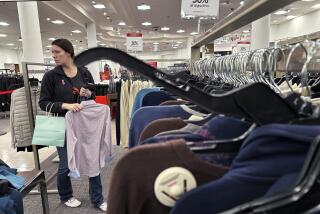Index Suggests Moderate Growth Ahead
- Share via
WASHINGTON — A key gauge of future economic activity was flat in June, the Conference Board said Tuesday in a report that suggests moderate growth lies ahead.
The private business research group said its index of leading indicators, designed to forecast economic trends six to nine months from now, had risen 0.3% in May after falling 0.1% in April.
The index climbed steadily each month through the first quarter, as the economic pace accelerated at the start of the year before leveling off in the second quarter.
Analysts said the June index was consistent with that pattern of slowing but continuing growth. They added that the report is likely to help reassure Federal Reserve Board policymakers that inflation is contained, at least in the short run.
Five out of the 10 separate measures of economic activity in the index strengthened in June, while five were weaker than in May.
“Its basic message is that expansion remains in place and it’s widespread, though it doesn’t appear to be as vigorous as it was at times in the past,” said Robert Dederick, economic consultant to Northern Trust Co. in Chicago.
The Conference Board said the strongest negative influences in June came from higher initial claims for state unemployment benefits and a shorter average factory workweek.
In addition, interest rates were less favorable, new applications for building permits were fewer, and delivery times sped up for finished goods--a sign that factories were not as busy as in May.
On Tuesday, the Dow Jones industrial average declined 10.91 points to 8,87.54, while bond prices fell, pushing up the yield on the benchmark 30-year Treasury to 6.49%, up from Monday’s 6.47%.
The positive influences on the June index came primarily from a soaring stock market and stronger money supply. In addition, orders were up for consumer and capital goods, and consumer expectations were stronger in June.
The National Assn. of Purchasing Management reported Friday that its index of nationwide industrial activity rose in July to 58.6% from 55.7% in June. It also said prices for several commodities were higher, which rattled markets at the end of the week.
Still, Dederick said financial markets seemed to have steadied after deciding the NAPM index was not unduly threatening and that it was unlikely the June leading indicators would have a strong influence.
“The fact that it shows the economy is not moving ahead as vigorously is in line with what the Fed wanted,” Dederick said. “So the implication is that there is no need for the Fed to do anything on Aug. 19.”
The central bank’s Federal Open Market Committee next meets on that date to consider interest rate strategy.
Last week the Commerce Department said gross domestic product slowed to a 2.2% annualized rate of growth in the second quarter from 4.9% in the first quarter.
Most economists expect annualized growth of about 3% in the second half, with faster expansion possible if consumer spending bounces back from a second-quarter slowdown.
More to Read
Inside the business of entertainment
The Wide Shot brings you news, analysis and insights on everything from streaming wars to production — and what it all means for the future.
You may occasionally receive promotional content from the Los Angeles Times.










